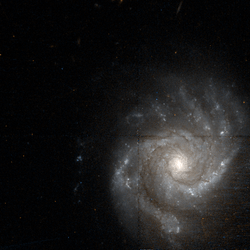NGC 3506
NGC 3506 is a spiral galaxy in constellation Leo. It is located at a distance of circa 300 million light years from Earth, which, given its apparent dimensions, means that NGC 3506 is about 115,000 light years across. The galaxy has two main spiral arms, with high surface brightness, which can be traced for half a revolution before they fade. One arm splits into four spiral arcs.[2]
| NGC 3506 | |
|---|---|
 NGC 3506 by Hubble Space Telescope | |
| Observation data (J2000 epoch) | |
| Constellation | Leo |
| Right ascension | 11h 03m 13.0s[1] |
| Declination | 11° 04′ 36″[1] |
| Redshift | 6408 ± 3 km/s[1] |
| Distance | 297 Mly (86 Mpc)[1] |
| Apparent magnitude (V) | 12.6 |
| Characteristics | |
| Type | Sc [1] |
| Apparent size (V) | 1′.2 × 1′.1[1] |
| Other designations | |
| UGC 6120, MCG +02-28-047, PGC 33379[1] | |
Two supernovae have been observed in NGC 3506, SN 2003L (type Ic) and 2017dfq (type Ia, mag. 15.3[3]). SN 2003L spectrum featured a relatively blue continuum, dominated by strong P-Cyg lines of Ca II (H and K) and Fe II and a relatively weaker Si II 635.5-nm line was also visible.[4]
It is an isolated galaxy.[5]
References
- "NASA/IPAC Extragalactic Database". Results for NGC 3506. Retrieved 2016-01-18.
- Sandage, A.; Bedke, J. (1994). The Carnegie Atlas of Galaxies. Volume I. Carnegie Institution of Washington.
- Latest Supernovae rochesterastronomy.org
- IAUC 8057: 2003P; 2003L, 2003M,, 2003O International Astronomical Union Circular January 25, 2003
- Hern?ndez-Toledo, H. M.; V?zquez-Mata, J. A.; Mart?nez-V?zquez, L. A.; Choi, Yun-Young; Park, Changbom (1 June 2010). "The UNAM-KIAS Catalog of Isolated Galaxies". The Astronomical Journal. 139 (6): 2525–2541. arXiv:1005.1571. Bibcode:2010AJ....139.2525H. doi:10.1088/0004-6256/139/6/2525.
External links
- NGC 3506 on WikiSky: DSS2, SDSS, GALEX, IRAS, Hydrogen α, X-Ray, Astrophoto, Sky Map, Articles and images
This article is issued from Wikipedia. The text is licensed under Creative Commons - Attribution - Sharealike. Additional terms may apply for the media files.